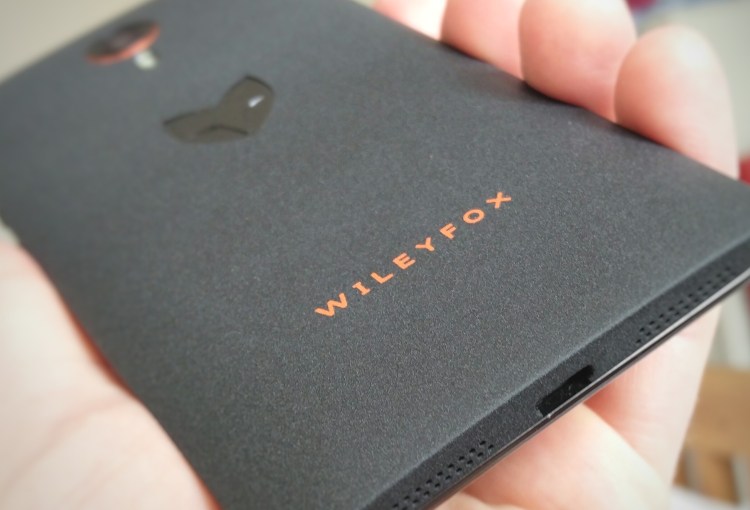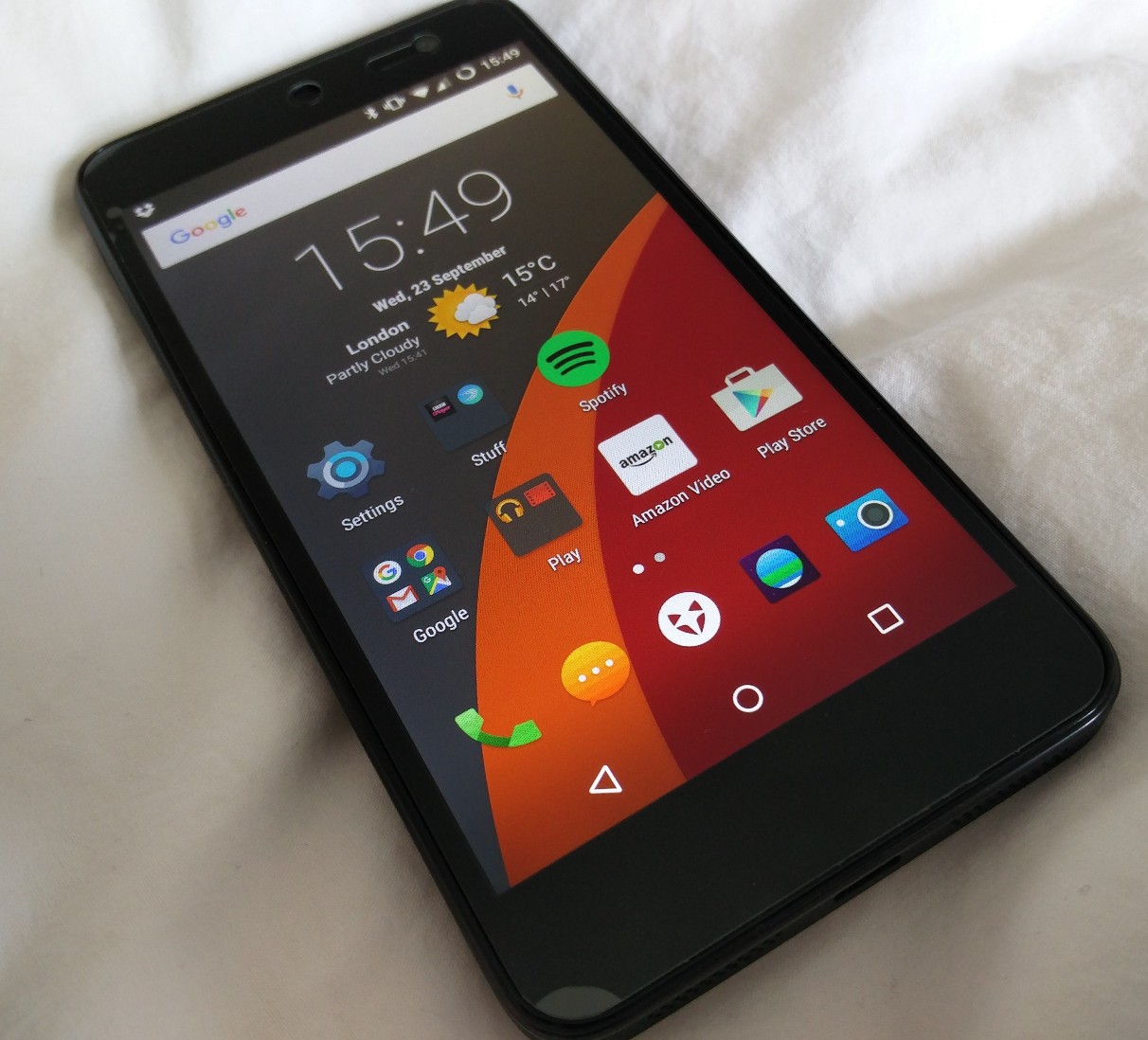Fledgling European mobile phone brand Wileyfox announced its arrival in the smartphone realm a month ago, and now the London-based company is preparing to launch its first ever product: The Wileyfox Swift.
Initially slated for launch this week, Wileyfox revealed that shipping for the $200 Android device has been delayed until September 30. But while you wait, VentureBeat has grabbed some serious hands-on time with the phone, and here’s the lowdown on what you need to know.
Vital stats
The Wileyfox Swift is powered by Cyanogen OS, the commercial, customizable Android-based operating system from Cyanogen Inc. It sports a Qualcomm Snapdragon 410 quad-core processor, 5″ Gorilla Glass screen (1,280 x 720 pixels), 13MP rear-facing camera, 5MP front-facing camera, 2GB of RAM, and 16GB of storage (expandable up to 32GB). It also supports 4G, has two SIM card slots, and it will set you back €179 EUR (£129 GBP / $205 USD).
As a slight aside, launching a month after the Swift is the souped-up €279 (£199 GBP / $315 USD) Wileyfox Storm, which offers a 5.5″ full HD display, Qualcomm Snapdragon 615 octa-core processor, a whopping 20MP rear-facing camera, 3GB RAM, and 32GB of storage (expandable up to 128GB).
Available for preorder now through the Wileyfox website, as well as online retailers such as Amazon, Expansys, and E-buyer, the Swift is pitched squarely at the EMEA (Europe, Middle East, and Africa) market, with localized call center support, a replacement screen service, and an extended three-year warranty offered for the equivalent of around $15 for each service.
That said, the phone can be purchased in other territories, including the U.S., but Wileyfox said the “experience will not be full” elsewhere. For example, in the U.S., data streaming would be limited because the phone uses CDMA — voice and SMS should be fine on the Swift, as would Wi-Fi, but 4G / LTE would suffer. And there won’t be dedicated phone support outside EMEA, either.
Look and feel
Perhaps the most immediately striking facet of the Wileyfox Swift is its looks — it doesn’t resemble a cheap phone, despite what its price would have you believe. The rough-ish, sandstone black rear, embossed logo, and colored brand marking gives it a premium feel.
The front side sports a clear screen with no physical buttons, and down the right edge you’ll find the volume control and power button. On the bottom edge is the micro-USB port and two speakers.
The Wileyfox Swift is noticeably light in the hand — at 135 grams, it’s 30 percent lighter than my OnePlus 2, though it is also around 0.5″ smaller. While this is good, it does make it feel a little bit cheaper to me — but that’s probably just because I’m used to a heftier handset.
Indeed, many people will like its deftness, and looking at other premium phones on the market, the Swift isn’t actually too light — the marginally larger Samsung Galaxy S6 weighs only 3 grams more, while the slightly smaller iPhone 6 comes in at 129 grams. In other words, the Swift is about the right weight for its size; it’s really just down to what you’re already accustomed to.
Under the hood
With Cyanogen OS on board, Wileyfox brings some useful features to the mainstream market. Cyanogen is already supported by many handsets, but in the West not many actually ship with the OS preinstalled.
Highlights include being able to lock some apps in protected folders on the home screen. Tap on a folder, hit the little padlock icon, enter a code, and voila.
Other neat little touches include Privacy Guard, which gives users easy access to control what data is shared with which apps. And with Truecaller built in, the Swift can block spam calls and texts from specific numbers — a giant smack in the face to robocallers everywhere.
General performance
One of the downsides of Cyanogen OS is that it is prone to bugs, and at times it’s not the most responsive to touch. For example, occasionally I would attempt to swipe down from the top to access notifications and settings, and literally nothing would happen. This was similar to what I experienced with the OnePlus One, which ran Cyanogenmod 12.
That said, it’s not prevalent enough for it to be a deal-breaker — it just gets a little frustrating at times for those 5 seconds or so I’m desperately trying to swipe the screen.
In terms of juice, the Wileyfox Swift packs a removable (yay!) 2500mAh battery that promises stand-by time of up to 200 hours and talk time of up to 10 hours (2G) or 8 hours (3G).
Of course, nobody really uses their smartphones for calling anymore — they use them for tweeting, WhatsApp-ing, Google Maps-ing, YouTube-ing, and Spotify-ing. I didn’t stress-test the battery; I used it as I would any phone throughout a day (Google Maps, Twitter, BBC News app, and very little media streaming), and it lasted from when I awoke to when I went to bed, at which point there was around 10 percent battery remaining.
Elsewhere, the 13MP camera works pretty well for daylight shots, but I found it lacked somewhat in clarity for low-lighting situations. But at $200, this was never promising the best lens on the market. The on-board dual speakers were actually pretty darn good for casual listening at this price point, though you would of course want to use a Bluetooth speaker if you’re hosting a party.
The cherry on the cake, for me, is the display. It may not be full HD, but I found the screen to be clear and crisp. Again, this isn’t going to be for perfectionists who love watching movies on their phone with all the trimmings, but for the price it’s definitely very good.
Dual-SIM
This feature gets a special mention. Dual-SIM phones are popular in many developing markets, but they’ve never really become much of a “thing” in the West. There’s no real reason why dual-SIM devices shouldn’t be popular in Europe or the U.S. — it was one of the reasons why I upgraded my personal phone to the OnePlus 2.
The use cases for dual-SIM are numerous. You can have one number for all your friends and family, and one for companies that may be inclined to call at inappropriate times. The second SIM slot can basically be your spam line, just like that Yahoo email account you keep for special occasions. You could have one domestic SIM and one business SIM, if you travel abroad often. Or you could have two domestic SIMs — one for calls and SMS, the other for Internet — if you find separate good deals from two companies.
And if you have absolutely no need for two SIMs, you don’t have to use that second slot.
Verdict
In our original assessment, we stated that Wileyfox wants to be the OnePlus of Europe. While the basic sentiment of that still rings true, it doesn’t really tell the whole picture — OnePlus sells premium phones at a knockdown price. The Wileyfox Swift is a decent mid-range device — and excellent value for the money — but it’s definitely not a premium phone.
The Wileyfox Swift should be well received when it finally goes to market. However, it sits in an awkward position for me. The customization options are excellent, but it feels a little like the handset is aimed at a more tech-savvy market, where fine-tuning privacy options are important. It’s a market, perhaps, that would be more inclined to shell out for a proper high-end phone.
That said, the Wileyfox Swift could find a sizable niche in the gift-giving fraternity. It’s the perfect price for someone to buy a family member / significant other for their birthday or Christmas. You probably wouldn’t buy a $600 iPhone for your dad, but you’d maybe drop a couple hundred bucks on a Swift.








